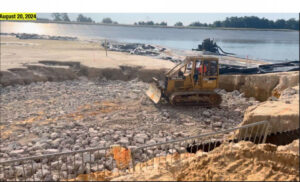

The Apopka City Council received an update on the city’s restoration plan for making the 250-million-gallon Golden Gem reclaimed water pond functional again following the formation of a sinkhole last year.
At the City Council’s Wednesday, Feb. 5, meeting, Da Huo, utility design manager at the city’s public service department, walked the City Council through an overview of the Golden Gem reclaimed water pond, including its history, the sinkhole formation, and the recommended next steps.
The Golden Gem reclaimed water pond is a 102.79-acre pond located at 3513 Golden Gem Road, Apopka, off S.R. 429. The pond is 4.3 miles from Rock Springs at Kelly Park; all the groundwater in the Golden Gem area ends up in Rock Springs, where the city has conducted most of its water testing.
The reclaimed water pond is divided into three sections – northern, central and southern – and was designed as a step-down terrace, with ground elevation the highest in the north and lowest in the south. There are two separate ponds located side by side within the reclaimed pond perimeter. The small one holds about 50 million gallons of water, while the large one holds 200 million gallons.
In November 2023, the pond’s water elevation reached an all-time high through a combination of rainwater and reclaimed water. In the northern section, the water level reached a depth of 22 feet deep, while it was over 30 feet deep in the southern section, according to Huo. This led to the January 5, 2024, sinkhole in the northern part, which was first discovered when soil erosion appeared in an infrared satellite image. On January 24, 2024, the city noticed the erosion line with a visual inspection; on January 30, 2024, the incident was reported to the state Department of Environmental Protection.
A local geotechnical engineering firm investigated the sinkhole between January and June of 2024.
Construction work for phase one of sinkhole repair took place between July and September 2024, with completion in September. Phase one involved only the plugging of the sinkhole itself. The pond is currently not operational.
After the sinkhole developed, consultants under the city of Apopka’s direction conducted water quality tests at three residential drinking walls in the pond’s area. The tests took place on May 15, 2024, and the results came back one week later showing no impact to the aquifer.
To plug the sinkhole, larger rear props were placed on the bottom to give more stability; smaller rocks laid on top of this layer to give more density, and at the top of this, a layer of compacted clays was laid to prevent water from seeping through. Following this construction, crews added a layer of concrete to the very top for stability.
The city is currently reviewing a contractor’s proposal to investigate liners in both ponds for potential improper material and/or installations.
Discussion between city staff and City Council occurred after Huo’s presentation.
Restoration plan
In order to restore the Golden Gem reclaimed water pond’s functionality, Huo laid out the following restoration plan:
1) A complete subsurface geophysical examination of the pond using technology; this scan will help the city know what to do about restoring the pond.
2) Remove existing membrane and install compacted clay as the pond’s bottom. The membrane/liner essentially serves the same purpose as compacted clay, but clay lasts much longer. Whereas the membrane could last between 20 to 40 years, the clay bottom could last a lifetime.
“Also, by using clay, you can build up the bottom elevation of the pond and give more separation from the pond bottom to the groundwater, which is one of the main causes of the (sinkhole) accident,” Huo said.
3) Closing off the northern cell completely by building a clay dam. City consultants informed the city that “the most worrisome area” is the northern section because that was where the sinkhole had formed, Huo said.
4) Incorporate a water circulation plan into the design that would include fountains and pumping systems to keep the pond’s water from becoming stationary. Stagnant water in a reclaimed water pond as large as Golden Gem could lead to a degradation of water quality over time, according to Huo. Design of the water circulation plan would have to be outsourced as opposed to being done in house, Huo said.
The Apopka Chief and The Planter are weekly community newspapers, independently owned and family operated, that have served the greater Apopka area in Central Florida since 1923 and 1965 respectively.
Follow The Apopka Chief on Facebook.
Follow The Apopka Chief on X.
Follow The Apopka Chief on Instagram.
